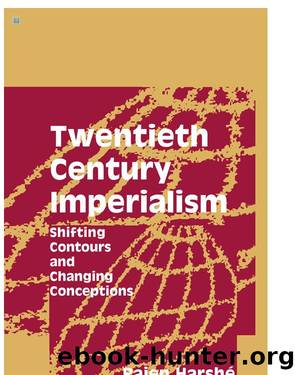Twentieth Century Imperialism by Unknown

Author:Unknown
Language: eng
Format: epub
Published: 2021-09-20T16:00:00+00:00
The Apartheid State Responds to the Challenges
As the ANC-led rebellion became difficult to contain after the Soweto riots, the ruling white circles of the NP chose to implement a purposive reformist programme to coopt the black masses. Under the Total Strategy (TS), 1979â84, the ruling party promised to give new direction to urban policy and industrial relations.44 The TS was primarily introduced to defend the interests of the capitalist classes which were ill at ease with the functioning of the apartheid system. Due to constant agitations against the system the entire production process was suffering periodical breakdowns. The capitalist classes were more keen on smooth and efficient functioning of the capitalist system. They also began to recognize the growing incompatibility between policy of racial discrimination and capitalism. Particularly, Harry Oppenheimer, the President of Anglo-American, openly stood for the removal of laws which obstructed the growth of private enterprises in South Africa. Even the Anglo-American business groups showed their inclination to reform the apartheid system. In the process of reshaping capitalism, the private sector in South Africa demonstrated its willingness to shoulder the economic burdens of the blacks. It took steps to solve their housing problems and widened its cooptive capabilities to ensure that the blacks, at least marginally, were able to share the benefits of capitalist development. Despite their changing outlook in the economic sphere, the capitalist classes were reluctant to promote the participation of trade union movements in decision making. This only aggravated the discontent within the trade union movements.
In the political sphere, the TS endeavoured to devise modes of power sharing and methods of political representation. The establishment of the tricameral legislature in 1983 was the culmination of this process. But the ruling party's efforts to coopt the Indian and coloured people by instituting separate legislatures for them opened up floodgates of protest from all over South Africa. This led to the birth of United Democratic Front (UDF) which gathered diverse groups under its mould to perpetuate the mass protest against apartheid. Along with these internal challenges, the apartheid state had to handle external challenges.
Within the southern African region, South Africa actively pursued the policy of destabilization to counter the support of frontline states to anti-apartheid struggles. It backed Union for the Total Independence of Angola (UNITA) in Angola and Movement for National Resistance (MNR) in Mozambique. Both these dissident movements were trying to oust the Afro-Marxist regimes in Angola and Mozambique respectively. Moreover, the SADF directly raided and bombarded the ANC bases in Zambia. Such aggressive policies of the apartheid state did bring about considerable economic dislocation in the region and led to the loss of human lives. However, active Soviet support and Cuban presence in the region continued to bolster the morale of anti-apartheid regimes and movements in the region. Namibia's independence in 1990, allowed them to face South Africa with greater confidence.
At the global level the South African state had to handle the challenges posed by sanctions against apartheid regimes. For instance, the international oil embargo was approved by the UN in 1973.
Download
This site does not store any files on its server. We only index and link to content provided by other sites. Please contact the content providers to delete copyright contents if any and email us, we'll remove relevant links or contents immediately.
| Africa | Americas |
| Arctic & Antarctica | Asia |
| Australia & Oceania | Europe |
| Middle East | Russia |
| United States | World |
| Ancient Civilizations | Military |
| Historical Study & Educational Resources |
Magic and Divination in Early Islam by Emilie Savage-Smith;(1195)
Ambition and Desire: The Dangerous Life of Josephine Bonaparte by Kate Williams(1087)
Operation Vengeance: The Astonishing Aerial Ambush That Changed World War II by Dan Hampton(986)
What Really Happened: The Death of Hitler by Robert J. Hutchinson(868)
London in the Twentieth Century by Jerry White(847)
Time of the Magicians by Wolfram Eilenberger(843)
Twilight of the Gods by Ian W. Toll(812)
The Japanese by Christopher Harding(798)
Papillon by Henry Charrière(794)
Lenin: A Biography by Robert Service(779)
The Devil You Know by Charles M. Blow(778)
Twelve Caesars by Mary Beard(766)
Freemasons for Dummies by Hodapp Christopher;(747)
The Churchill Complex by Ian Buruma(730)
Napolean Hill Collection by Napoleon Hill(703)
The Enlightenment by Ritchie Robertson(691)
Henry III by David Carpenter;(688)
Bohemians, Bootleggers, Flappers, and Swells: The Best of Early Vanity Fair by Bohemians Bootleggers Flappers & Swells- The Best of Early Vanity Fair (epub)(684)
The Rise and Triumph of the Modern Self by Unknown(657)
